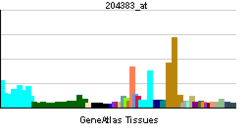- DGCR14
-
DiGeorge syndrome critical region gene 14 Identifiers Symbols DGCR14; DGCR13; DGS-H; DGS-I; DGSH; DGSI; ES2; Es2el External IDs OMIM: 601755 MGI: 107854 HomoloGene: 11184 GeneCards: DGCR14 Gene Gene Ontology Molecular function • molecular_function Cellular component • nucleus
• catalytic step 2 spliceosomeBiological process • nuclear mRNA splicing, via spliceosome
• nervous system development
• RNA splicingSources: Amigo / QuickGO RNA expression pattern 


More reference expression data Orthologs Species Human Mouse Entrez 8220 27886 Ensembl ENSG00000100056 ENSMUSG00000003527 UniProt Q96DF8 Q3UFM6 RefSeq (mRNA) NM_001024733 NM_001081633 RefSeq (protein) NP_001019904 NP_001075102 Location (UCSC) Chr 22:
19.12 – 19.13 MbChr 16:
17.9 – 17.91 MbPubMed search [1] [2] Protein DGCR14 is a protein that in humans is encoded by the DGCR14 gene.[1][2][3]
This gene is located within the minimal DGS critical region (MDGCR) thought to contain the gene(s) responsible for a group of developmental disorders. These disorders include DiGeorge syndrome, velocardiofacial syndrome, conotruncal anomaly face syndrome, and some familial or sporadic conotruncal cardiac defects which have been associated with microdeletion of 22q11.2. The encoded protein may be a component of C complex spliceosomes, and the orthologous protein in the mouse localizes to the nucleus.[3]
References
- ^ Gong W, Emanuel BS, Collins J, Kim DH, Wang Z, Chen F, Zhang G, Roe B, Budarf ML (Dec 1996). "A transcription map of the DiGeorge and velo-cardio-facial syndrome minimal critical region on 22q11". Hum Mol Genet 5 (6): 789–800. doi:10.1093/hmg/5.6.789. PMID 8776594.
- ^ Gong W, Emanuel BS, Galili N, Kim DH, Roe B, Driscoll DA, Budarf ML (Aug 1997). "Structural and mutational analysis of a conserved gene (DGSI) from the minimal DiGeorge syndrome critical region". Hum Mol Genet 6 (2): 267–276. doi:10.1093/hmg/6.2.267. PMID 9063747.
- ^ a b "Entrez Gene: DGCR14 DiGeorge syndrome critical region gene 14". http://www.ncbi.nlm.nih.gov/sites/entrez?Db=gene&Cmd=ShowDetailView&TermToSearch=8220.
Further reading
- Rizzu P, Lindsay EA, Taylor C et al. (1996). "Cloning and comparative mapping of a gene from the commonly deleted region of DiGeorge and Velocardiofacial syndromes conserved in C. elegans". Mamm. Genome 7 (9): 639–643. doi:10.1007/s003359900197. PMID 8703114.
- Lindsay EA, Rizzu P, Antonacci R et al. (1996). "A transcription map in the CATCH22 critical region: identification, mapping, and ordering of four novel transcripts expressed in heart". Genomics 32 (1): 104–112. doi:10.1006/geno.1996.0082. PMID 8786095.
- Botta A, Lindsay EA, Jurecic V, Baldini A (1998). "Comparative mapping of the DiGeorge syndrome region in mouse shows inconsistent gene order and differential degree of gene conservation". Mamm. Genome 8 (12): 890–895. doi:10.1007/s003359900606. PMID 9383280.
- Puech A, Saint-Jore B, Funke B et al. (1998). "Comparative mapping of the human 22q11 chromosomal region and the orthologous region in mice reveals complex changes in gene organization". Proc. Natl. Acad. Sci. U.S.A. 94 (26): 14608–14613. doi:10.1073/pnas.94.26.14608. PMC 25069. PMID 9405660. http://www.pubmedcentral.nih.gov/articlerender.fcgi?tool=pmcentrez&artid=25069.
- Lindsay EA, Harvey EL, Scambler PJ, Baldini A (1998). "ES2, a gene deleted in DiGeorge syndrome, encodes a nuclear protein and is expressed during early mouse development, where it shares an expression domain with a Goosecoid-like gene". Hum. Mol. Genet. 7 (4): 629–635. doi:10.1093/hmg/7.4.629. PMID 9499415.
- Taricani L, Tejada ML, Young PG (2002). "The fission yeast ES2 homologue, Bis1, interacts with the Ish1 stress-responsive nuclear envelope protein". J. Biol. Chem. 277 (12): 10562–10572. doi:10.1074/jbc.M110686200. PMID 11751918.
- Tchernev VT, Mansfield TA, Giot L et al. (2002). "The Chediak-Higashi protein interacts with SNARE complex and signal transduction proteins". Mol. Med. 8 (1): 56–64. PMC 2039936. PMID 11984006. http://www.pubmedcentral.nih.gov/articlerender.fcgi?tool=pmcentrez&artid=2039936.
- Jurica MS, Licklider LJ, Gygi SR et al. (2002). "Purification and characterization of native spliceosomes suitable for three-dimensional structural analysis". RNA 8 (4): 426–439. doi:10.1017/S1355838202021088. PMC 1370266. PMID 11991638. http://www.pubmedcentral.nih.gov/articlerender.fcgi?tool=pmcentrez&artid=1370266.
- Strausberg RL, Feingold EA, Grouse LH et al. (2003). "Generation and initial analysis of more than 15,000 full-length human and mouse cDNA sequences". Proc. Natl. Acad. Sci. U.S.A. 99 (26): 16899–16903. doi:10.1073/pnas.242603899. PMC 139241. PMID 12477932. http://www.pubmedcentral.nih.gov/articlerender.fcgi?tool=pmcentrez&artid=139241.
- Ota T, Suzuki Y, Nishikawa T et al. (2004). "Complete sequencing and characterization of 21,243 full-length human cDNAs". Nat. Genet. 36 (1): 40–45. doi:10.1038/ng1285. PMID 14702039.
- Collins JE, Wright CL, Edwards CA et al. (2005). "A genome annotation-driven approach to cloning the human ORFeome". Genome Biol. 5 (10): R84. doi:10.1186/gb-2004-5-10-r84. PMC 545604. PMID 15461802. http://www.pubmedcentral.nih.gov/articlerender.fcgi?tool=pmcentrez&artid=545604.
- Gerhard DS, Wagner L, Feingold EA et al. (2004). "The status, quality, and expansion of the NIH full-length cDNA project: the Mammalian Gene Collection (MGC)". Genome Res. 14 (10B): 2121–2127. doi:10.1101/gr.2596504. PMC 528928. PMID 15489334. http://www.pubmedcentral.nih.gov/articlerender.fcgi?tool=pmcentrez&artid=528928.
- Olsen JV, Blagoev B, Gnad F et al. (2006). "Global, in vivo, and site-specific phosphorylation dynamics in signaling networks". Cell 127 (3): 635–648. doi:10.1016/j.cell.2006.09.026. PMID 17081983.
Categories:- Human proteins
- Chromosome 22 gene stubs
Wikimedia Foundation. 2010.
